Whenever I’m traveling to a country that speaks a different language, I always try and learn a few phrases in advance and convince myself that I’m a natural. However, that notion usually comes crashing down about five minutes after stepping off the plane and nobody has a clue what I’m trying to say when I need directions.

If that sounds familiar to you then this nifty in-ear device could be exactly what you need. Set to launch this autumn, the Pilot earpiece by Waverly Labs allows two people to communicate using two completely different languages and still clearly understand each other.
Working much like the Babel Fish from ‘ The Hitchhikers Guide to the Galaxy ,’ the Pilot can translate live speech. So, if you have it in your ear and you’re talking to someone who speaks French – you will hear what they say in English and they will hear you in French.
Both participants in the conversation will need to be wearing a Pilot but the manufacturers will be selling them in pairs so you don’t need to seek out owners of the device in the street.
Regarding exactly how the device works, Waverly Labs has remained tight-lipped, only saying it uses “translation technology” and is connected to an app on your phone, which works offline. My assumption is that it’s your phone doing the translating and the earpiece is simply where you hear it come through. The ear pieces can also be used as wireless headphones for listening to music.
In that sense, what Waverly Labs is offering isn’t much different to Skype’s in-call translator feature . If Skype was to make that available as a standalone app that connects to any headphones then it would essentially be the same thing.
But if the Pilot is your type of gadget, it is available to preorder from May 25 when Waverly Labs launches an Indiegogo campaign to support the project. It comes in three colors – black, white and red – and will set you back between $129-$179. It is expected to retail for $250-$300 after the limited preorders run out.
Of course, as with any crowdfunding campaign, there is always a risk that the product will fail to launch but something tells me there will be a lot of happy people waiting for this one.
Xbox One July update to add Snap Mode for Achievements, spoken language option, digital bundles, and more
Microsoft today detailed what gamers can expect in the next Xbox One update, which is slated to arrive in July . There are five new features on tap: Snap Mode for Achievements, double-tap to Snap, choice of spoken language, future digital bundles and compilation discs, as well as being able to ‘Like’ Game DVR clips.

The first feature lets you track and view your achievements in real time without ever leaving the game. The new mode also offers a “Get Help” option for any achievements you might be struggling with by scanning the Web for relevant tips to show you right on your TV.
Related to this, the Snap Center will now be accessible by simply double-tapping the Xbox button on your controller (or if you already have an app snapped, the action will switch you between your game and the app). From there, you can launch Achievements or any other snap-able app, without leaving your game.
Next up, Xbox One owners in New Zealand, Ireland, and Austria will be able to select voice control using the English or German voice models from other countries. If you’re an expat in an English-speaking country, you’ll also be able to use a different English language model.
Microsoft is also adding support for future digital bundles and compilation discs. The company says it is working to give publishers more flexibility when combining game titles and game content. While it’s unlikely that we’ll see the advantages of this addition soon, the fact that it’s being added in next month suggests they’re almost ready to be announced.
Finally, gamers will able to “Like” all their favorite Game DVR clips as well as activity feed items in SmartGlass. This serves no real purpose other than helping you keep track of what you enjoy, and probably spamming your friends in the process.
We’ll let you know when the update rolls out to everyone. Select Xbox Live members will be getting these features this week (by invite only).
See also – Xbox VP Mike Nichols on the state of Xbox One and what Microsoft needs to do to beat Sony and Microsoft releases 32-bit and 64-bit Windows drivers for the Xbox One controller
Hands-on with Xiaomi’s Mi 4: A gorgeous, robust phone with high-end specs at a mid-range price
Chinese smartphone manufacturer Xiaomi released its fourth-generation smartphone today and the Mi 4 is impressive — largely because the company has finally used metal for the frame of its phone, getting rid of the plasticky feel that was a letdown in its predecessors.

The Mi 4 is also once again packed with high-end specs that have led to CEO Lei Jun touting it as the fastest-ever smartphone globally, replacing the Mi 3.
First impressions: the Mi 4 actually looks like a bigger version of the iPhone 4. Despite being bigger than the iPhone 4 though, it is extremely light, weighing only 149g. When held, the phone feels very solid and doesn’t seem at all like a CNY1,999 ($322) device. Indeed, Xiaomi seems to have managed to create a high-end device both in terms of looks and specs this time round, all the while sporting a mid-tier price.
Xiaomi has also moved away from the garish neon colors that the Mi 4’s predecessors sported, and only unveiled two colors — black and white — as well as a series of wood covers that are reminiscent of the Moto X’s wood finishes .
The Mi 4 screen has also been upgraded to improve the appearance of colors. It boasts 84 percent of NTSC color support, which Xiaomi says is close to Adobe’s RGB standard. The 1080p resolution already produces impressive graphics, and the new boost in saturation make browsing through them a joy, as the colors are significantly more vibrant.
The screen is also extremely sensitive to touch, so much so that it can be used even when your hands are damp.
As the Mi 4 runs on a 2.5GHz Qualcomm Snapdragon 801 processor, its performance is naturally up to standard. I played Temple Run on the phone and was impressed by how speedy and smooth the gameplay was, without any lag at all.
Xiaomi has also introduced a series of improvements to its camera to compete with fellow Android manufacturers. Other than a robust 8-megapixel front-facing camera which would appeal to those who are sick and tired of taking low-quality selfies or video calls, the rear camera also sees a few new features which can come in very handy.
An exposure adjuster lets you dial up or down the brightness level before you even press the shutter, while a ‘smart flash’ merges two photos (one without flash and one with auto flash) to make for a better picture. There is also an image tracker which lets you select a focal point that the camera will then track, no matter how the object moves, which can come in useful for taking photos of kids or animals. Samsung and HTC introduced selective focus tools in their latest flagship smartphones, and Xiaomi has joined the fray too with a similar option — after taking a photo, you can select which part of the photo should be in focus.
At this price point, the Mi 4 is an extremely promising Android device — and looks set to be a game-changer. After all, it brings to the Android smartphone scene a device that not only includes the use of stainless steel for a solid frame, but also 4G support. It seems like Xiaomi has “graduated” from the mass of low-end Android devices and actually come up with something that’s both high-end in specs and appearance. Fellow Android manufacturers including Samsung and HTC should very well be shivering in their shoes now, though OnePlus One with its customizable software and high-end performance at a mid-range price may not have that much cause to fear (probably till the unveiling of Xiaomi’s MIUI V6 operating system on August 16).
To this extent, Xiaomi has also taken a page out of Apple’s book to introduce a CNY99 ($16) insurance package (something like Apple Care), which covers screen breakage and accidental water damage.
Headline image via Xiaomi
